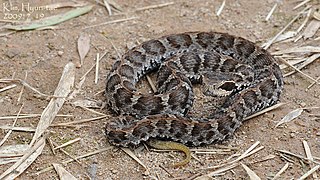
Gloydius himalayanus also known as the Himalayan pit viper or the Himalayan viper is a venomous pitviper species found along the southern slopes of the Himalayas in Pakistan, India and Nepal. No subspecies are currently recognized. Himalayan pit vipers have been found up to 4900m above sea level, which makes it the highest living snake ever found.

Trimeresurus stejnegeri is a species of venomous pit viper endemic to Asia. Two subspecies are currently recognized, including the nominate subspecies described here.

Crotalus helleri or Crotalus oreganus helleri, also known commonly as the Southern Pacific rattlesnake, the black diamond rattlesnake, and by several other common names, is a pit viper species or subspecies found in southwestern California and south into Baja California, Mexico, that is known for its regional variety of dangerous venom types. It is sometimes considered a subspecies of Crotalus oreganus.

Gloydius blomhoffii, commonly known as the mamushi, Japanese moccasin, Japanese pit viper, Qichun snake, Salmusa or Japanese mamushi, is a venomous pit viper species found in Japan. It was once considered to have 4 subspecies, but it is now considered monotypic.

Gloydius halys is a venomous pitviper species found within a wide range that stretches across Asia, from Russia, east of the Urals, eastwards through China. Five subspecies are currently recognized, including the nominotypical form described here.

Crotalus oreganus, commonly known as the Western rattlesnake or northern Pacific rattlesnake, is a venomous pit viper species found in western North America from the Baja California Peninsula to the southern interior of British Columbia.

The Great Basin rattlesnake is a venomous pit viper species found in the Great Basin region of the United States.

Ovophis okinavensis, commonly known as the hime habu (ヒメハブ), Ryukyu Island pit viper, and the Okinawan pitviper, is a venomous pitviper species found in the Ryukyu Islands of Japan. No subspecies are currently recognized.

Gloydius intermedius, or Central Asian pit viper, is a venomous species of pitviper endemic to northern Asia. Three subspecies are currently recognized, including the nominate subspecies described here.
Gloydius monticola is a venomous pitviper species endemic to southern China. A small and darkly colored snake with no visible color pattern, it is found high in the mountains of northern Yunnan province. No subspecies are currently recognized.
Gloydius shedaoensis is a venomous pitviper species found only on Shedao Island in China. Although very small, this island is home to an extraordinarily large population of these snakes. No subspecies are currently recognized.
Gloydius strauchi is a species of venomous pit viper in the subfamily Crotalinae of the family Viperidae. The species is native to western China. It is a small snake with a pattern of four longitudinal stripes, although some older specimens may be a uniform black. G. strauchi may be distinguished from G. monticola by its higher midbody dorsal scale count. This species jointly holds the altitude record for pitvipers together with Crotalus triseriatus of Mexico, both being found even above the tree line at over 4,000 m (13,000 ft). No subspecies were recognized as being valid, until a recent publication re-evaluated the taxonomic statuses of populations of G. strauchi and described the eastern Tibetan populations as a new species.

Gloydius ussuriensis is a venomous pitviper species endemic to far east Russia, northeastern China and the Korean Peninsula. No subspecies are currently recognized.

Gloydius brevicauda is a venomous pitviper species endemic to China and the Korean Peninsula.
Bothrocophias andianus is a venomous pit viper species endemic to the Andes in South America. No subspecies are currently recognized.
Gloydius caucasicus, the Caucasian pit viper, is a species of venomous snake in the genus Gloydius found in Turkmenistan, Azerbaijan, Iran, and Afghanistan.










